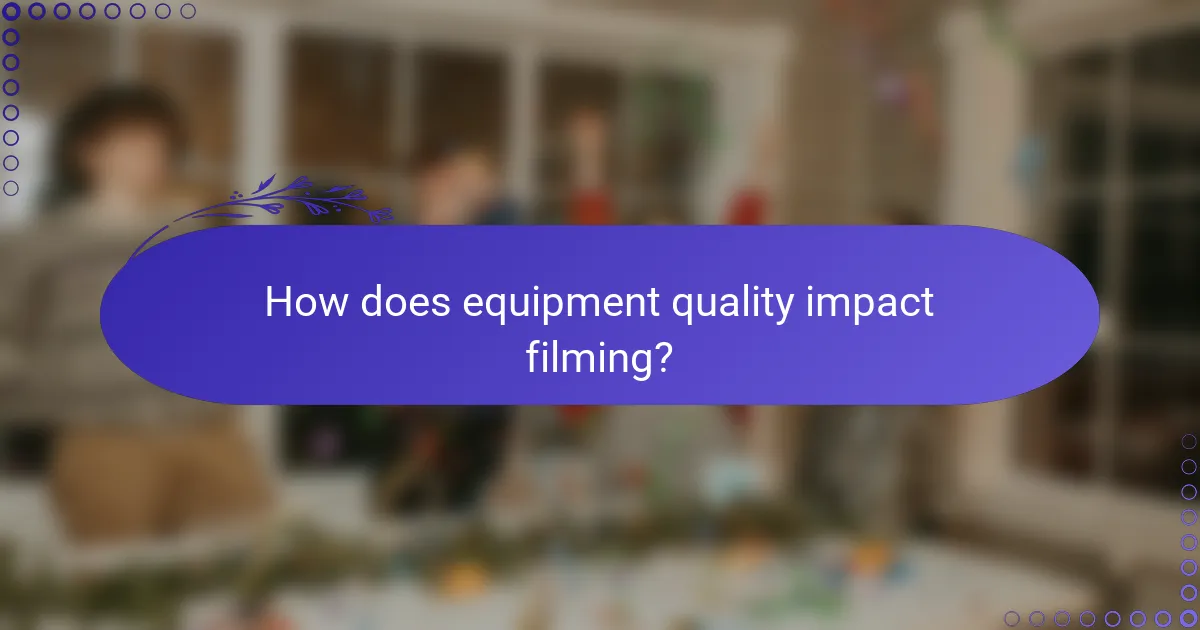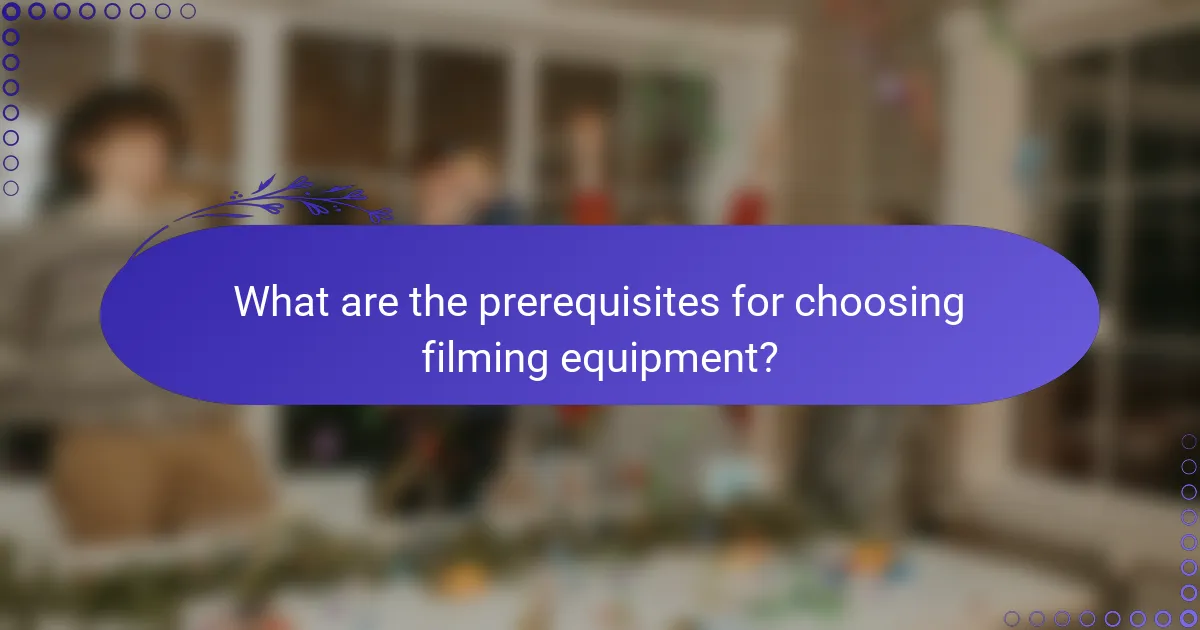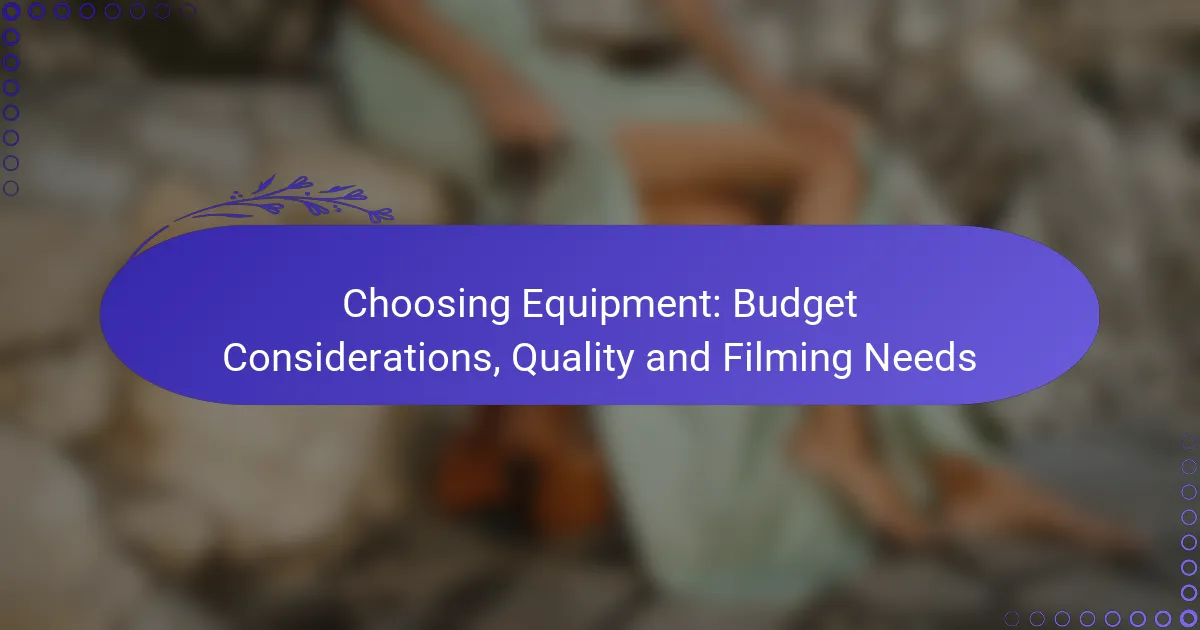Choosing the right filming equipment requires a careful balance between budget, quality, and specific project needs. It’s crucial to identify essential features that align with your creative vision while ensuring that your investment does not compromise the overall production value. By understanding how different gear impacts clarity and performance in various conditions, you can make informed decisions that enhance your content without overspending.

What equipment should I choose for my budget?
Choosing equipment for your budget involves balancing cost, quality, and your specific filming needs. Consider what features are essential for your projects and how much you can realistically spend without compromising on quality.
Entry-level cameras under $500
Entry-level cameras are ideal for beginners or those on a tight budget. Models in this price range often include basic features suitable for casual photography and videography, such as 1080p video recording and automatic settings.
Popular options include the Canon EOS Rebel T7 and Nikon D3500. These cameras typically offer interchangeable lenses, allowing for some creative flexibility as you develop your skills.
Mid-range cameras between $500 and $1500
Mid-range cameras provide a significant upgrade in quality and features, making them suitable for enthusiasts and semi-professionals. Look for models that support 4K video, better low-light performance, and advanced autofocus systems.
Examples include the Sony Alpha a6400 and Fujifilm X-T30. These cameras often come with improved build quality and more customizable settings, allowing for greater creative control.
High-end cameras over $1500
High-end cameras are designed for professionals who demand the best in image quality and performance. These models typically feature full-frame sensors, superior autofocus, and advanced video capabilities, including 4K and 6K recording options.
Consider options like the Canon EOS R5 or Sony A7 III. While the investment is substantial, the return in terms of image quality and professional features can be worth it for serious filmmakers and photographers.

How does equipment quality impact filming?
The quality of filming equipment significantly influences the final output, affecting clarity, color accuracy, and overall production value. Higher quality gear often results in better image resolution and performance in various lighting conditions, which can elevate the viewer’s experience.
Importance of lens quality
Lens quality is crucial as it directly affects sharpness, contrast, and color rendition in your footage. High-quality lenses minimize distortion and aberrations, ensuring that images are clear and true to life. Investing in good lenses can make a noticeable difference in the final product.
When selecting lenses, consider factors such as aperture size and focal length. A lens with a wider aperture allows for better performance in low light and more control over depth of field, which can enhance the storytelling aspect of your film.
Sensor size and its effects
The sensor size of a camera plays a vital role in determining image quality, particularly in low-light situations. Larger sensors typically capture more light, resulting in clearer images with less noise. This is especially important for filmmakers working in varied lighting environments.
For example, full-frame sensors are often preferred for professional filmmaking due to their superior dynamic range and depth of field control. However, they can be significantly more expensive than crop sensors, which may suffice for smaller projects or budget constraints.
Durability and build quality considerations
Durability and build quality are essential for equipment used in diverse filming conditions. Cameras and lenses that are weather-sealed and constructed from robust materials can withstand harsh environments, reducing the risk of damage during shoots. This is particularly important for outdoor filming or in challenging settings.
When assessing durability, look for equipment that has a proven track record in the field. Consider the potential costs of repairs or replacements, as investing in higher-quality, durable gear can save money in the long run by minimizing downtime and maintenance needs.

What filming needs should I consider?
When choosing filming equipment, it’s essential to assess your specific filming needs, including the type of content you plan to create, the filming environment, and the lighting conditions. These factors will significantly influence both the quality of your production and your overall budget.
Type of content: vlogs vs. documentaries
The type of content you are producing will dictate your equipment choices. Vlogs typically require lightweight, portable gear that allows for quick setup and mobility, such as compact cameras or smartphones. In contrast, documentaries often necessitate higher-quality cameras, tripods, and audio equipment to capture detailed visuals and clear sound in various settings.
Consider the storytelling style as well; vlogs may benefit from action cameras or gimbals for dynamic shots, while documentaries might require DSLR or mirrorless cameras for better image quality and versatility in different environments.
Indoor vs. outdoor filming requirements
Indoor and outdoor filming present distinct challenges that affect your equipment selection. Indoor filming often requires additional lighting solutions, such as softboxes or LED panels, to ensure adequate illumination in potentially dim environments. Outdoor filming, on the other hand, may necessitate weather-resistant gear and stabilization equipment to handle varying conditions.
Evaluate the locations you plan to shoot in; for instance, if filming in a crowded urban area, consider portable equipment that can be easily transported and set up quickly.
Lighting conditions and equipment
Lighting is a critical factor in achieving high-quality footage. Different lighting conditions, such as bright sunlight or low-light environments, require specific equipment adjustments. For bright outdoor shoots, neutral density filters can help manage exposure, while in low-light situations, fast lenses and external lights become essential.
Investing in versatile lighting equipment, like adjustable LED lights, can provide flexibility for various scenarios. Always test your setup in the actual filming environment to ensure that your lighting choices meet your creative vision and technical requirements.

What are the best brands for filming equipment?
The best brands for filming equipment include Canon, Sony, and Nikon, each offering unique strengths tailored to different filming needs. Choosing the right brand depends on your specific requirements, such as versatility, video quality, or photography capabilities.
Canon for versatility
Canon is renowned for its versatile range of cameras and lenses, making it a popular choice for both amateur and professional filmmakers. Their DSLRs and mirrorless models often feature user-friendly interfaces and robust autofocus systems, which are essential for dynamic shooting environments.
When considering Canon, look for models like the EOS R series for video and the EOS 90D for hybrid shooting. These options typically range from around $1,000 to $3,000, depending on the features and accessories included.
Sony for video quality
Sony stands out for its exceptional video quality, particularly in its Alpha series of mirrorless cameras. These cameras often excel in low-light conditions and offer advanced video features like 4K recording and high frame rates, making them ideal for serious videographers.
Popular models like the Sony A7S III can cost between $3,500 and $4,500, but they deliver professional-grade results. Ensure to invest in quality lenses to maximize the potential of your Sony camera.
Nikon for photography
Nikon is a strong contender for photographers seeking high-quality still images, with a reputation for producing excellent color accuracy and dynamic range. Their DSLRs and mirrorless options cater to various skill levels, from beginners to seasoned professionals.
Consider the Nikon Z series for a modern mirrorless experience or the D850 for a powerful DSLR. Prices typically range from $1,200 to $3,500, depending on the model and additional features.

How can I balance budget and quality?
Balancing budget and quality involves prioritizing your essential needs while being open to alternatives that can save costs. Focus on features that directly impact your filming requirements and explore options like used gear or rentals to maximize your investment.
Prioritize essential features
Identify the key features that are crucial for your filming needs. For instance, if you’re shooting in low light, prioritize cameras with larger sensors and better ISO performance. Make a list of must-have specifications versus nice-to-have extras to guide your purchasing decisions.
Consider the type of content you will produce. For example, if you are primarily creating online videos, a decent camera with good audio capabilities may suffice, while a feature-rich setup might be necessary for high-end productions.
Consider used or refurbished options
Buying used or refurbished equipment can significantly reduce costs while still providing quality gear. Look for reputable sellers or platforms that offer warranties or return policies to ensure you are making a safe investment.
Check local classifieds or online marketplaces for deals. Often, you can find professional-grade equipment at a fraction of the original price, especially if you are willing to negotiate or wait for the right opportunity.
Leverage rental services for high-end gear
Renting equipment can be a cost-effective way to access high-end gear without the hefty price tag. Many rental services offer flexible terms, allowing you to rent for a day, a week, or longer, depending on your project needs.
Evaluate your project timeline and budget to determine if renting is more economical than purchasing. For example, if you need a specific lens for a single shoot, renting it can save you money while ensuring you have the best tools for the job.

What are the prerequisites for choosing filming equipment?
Choosing filming equipment requires understanding your budget, quality expectations, and specific filming needs. These prerequisites help ensure that the equipment you select aligns with your project goals and financial constraints.
Budget Considerations
Establishing a budget is crucial when selecting filming equipment. Determine how much you can allocate for equipment, including cameras, lenses, lighting, and audio gear. A reasonable starting point for a basic setup might range from a few hundred to several thousand dollars, depending on your requirements.
Consider both initial costs and ongoing expenses, such as maintenance and accessories. Avoid overspending on high-end gear if your project does not demand it; instead, focus on essential items that fit within your budget.
Quality
Quality is a key factor in filming equipment selection, as it directly impacts the final output. Assess the minimum quality standards required for your project, such as resolution, frame rate, and dynamic range. For instance, a 4K camera may be necessary for professional projects, while 1080p might suffice for online content.
Research equipment reviews and user feedback to gauge performance and reliability. Investing in reputable brands can often yield better long-term results, as they typically offer superior build quality and customer support.
Filming Needs
Your specific filming needs will dictate the type of equipment you should choose. Consider the environment in which you will be filming, such as indoor versus outdoor settings, and the types of shots you plan to capture. For example, if you need to film in low light, prioritize cameras with good low-light performance.
Additionally, think about the type of content you are creating. Documentaries may require lightweight, portable gear, while narrative films might benefit from more advanced setups. Create a checklist of essential features based on your filming style to guide your equipment selection process.
